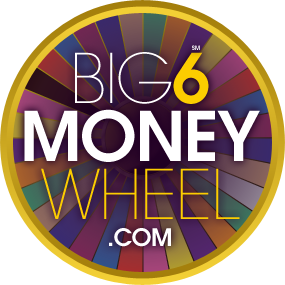Big 6 Money Wheel Variations
There are a number of Big 6 Money Wheel variations. Each variation depends on the number of segments, the different symbols in the segments, and the payoff odds of the symbol selected.
Money wheel
The Money Wheel variation is common in casinos in the United States.
The symbols corresponds to $1, $2, $5, $10 and $20 bills - plus two special symbols, usually a joker and the casino logo, which appear only once each.
The joker and the logo pay at odds of 40 to 1 or 45 to 1, depending on local gaming regulations or the practice of the casino.
| Symbol | Payoff | |
| $1.00 | 1 To 1 | |
| $2.00 | 2 To 1 | |
| $5.00 | 5 To 1 | |
| $10.00 | 10 To 1 | |
| $20.00 | 20 To 1 | |
| Joker | 40 To 1 | |
| Casino Logo | 40 To 1 |
The house advantage or edge (the proportion of the stakes that the casino expects to win on average) of this game is one of the highest of most casino games. It ranges from 11.1% on the $1-bill bet to more than 24% on the joker or logo (when it pays at 40 to 1).
Dice wheel
The symbols on the wheel represent some of the 216 possible combinations of three die. Sometimes the same symbol appears in more than one segment. Players wager on the numbers 1 through 6. If the number appears on one of the dice in the winning segment, the dealer pays at 1 to 1. If the number appears on two of the dice, the dealer pays at 2 to 1. If the number appears on three of the dice, the dealer pays at 3 to 1.
One example of a dice wheel, manufactured by H. C. Evans & Co. of Chicago (or its successor), is divided into 54 segments. Each of the triples appears four times. The following doubles each appears four times: 2, 1, 1; 2, 2, 1; 4, 3, 3; 5, 4, 4; 6, 5, 5; and 6, 6, 3. The following combinations each appear three times: 3, 2, 1; and 6, 5, 4.
In the example above, there are 54 possible outcomes for a single spin of the wheel. For a specific number:
there are 7 possible outcomes, where one die only will match the number;
there are 4 possible outcomes, where two dice only will match; and
there are 4 possible outcomes, where all three dice will match.
At odds of 1 to 1, 2 to 1 and 3 to 1 respectively for each of these types of outcome, the expected loss as a percentage of the stake wagered is:
1 - [(7/54) * 2 + (4/54) * 3 + (4/54) * 4] = 22.2%
This variety is seldom seen in casinos, but frequently seen in carnivals, or charity fund-raisers.
United Kingdom and New Zealand variations
A legal Big 6 Money Wheel game in the United Kingdom or New Zealand involves a wheel at least 1.5 meters in diameter divided into 52 segments, each marked with one of seven symbols (referred to as A to G). The table below lists the frequency of the symbols, their probability, the associated odds specified in the United Kingdom or New Zealand, and the house advantage or edge.
| Symbol | Number of segments | Probability of winning | Odds offered in UK | House edge in UK | Odds offered in NZ | House edge in NZ |
| A | 1 out of 52 | 1.9% | 50 to 1 | 1.9% | 47 to 1 | 7.7% |
| B | 1 out of 52 | 1.9% | 50 to 1 | 1.9% | 47 to 1 | 7.7% |
| C | 2 out of 52 | 3.9% | 20 to 1 | 19.2% | 23 to 1 | 7.7% |
| D | 4 our of 52 | 7.7% | 10 to 1 | 15.4% | 11 to 1 | 7.7% |
| E | 8 out of 52 | 15.4% | 5 to 1 | 7.7% | 5 to 1 | 7.7% |
| F | 12 out of 52 | 23.1% | 3 to 1 | 7.7% | 3 to 1 | 7.7% |
| G | 24 out of 52 | 46.2% | 1 to 1 | 7.7% | 1 to 1 | 7.7% |
Other variants
One variant called "Mississippi Derby" was used for a short time at the Grand Casino in Gulfport, Mississippi. (The casino was destroyed in 2005 by Hurricane Katrina.) The symbols were combinations of three of a number of different horses, arranged to represent a winner, a second-placed horse and a third-placed horse. (The horses were represented in three rings, with the winner on the outer ring.) Players wagered on particular horses to "win", "place" or "show", as with betting in horse racing. The payoffs varied from horse to horse, depending on how many times and where the horse appeared on the rings. Odds ranged from 40 to 1 for the "long-shot" to win, down to 1-2 for the "favorite" to show.


 Blackjack
Blackjack Craps
Craps Three Card Poker
Three Card Poker Baccarat
Baccarat Jokers Wild Video Poker
Jokers Wild Video Poker Pai Gow Poker
Pai Gow Poker